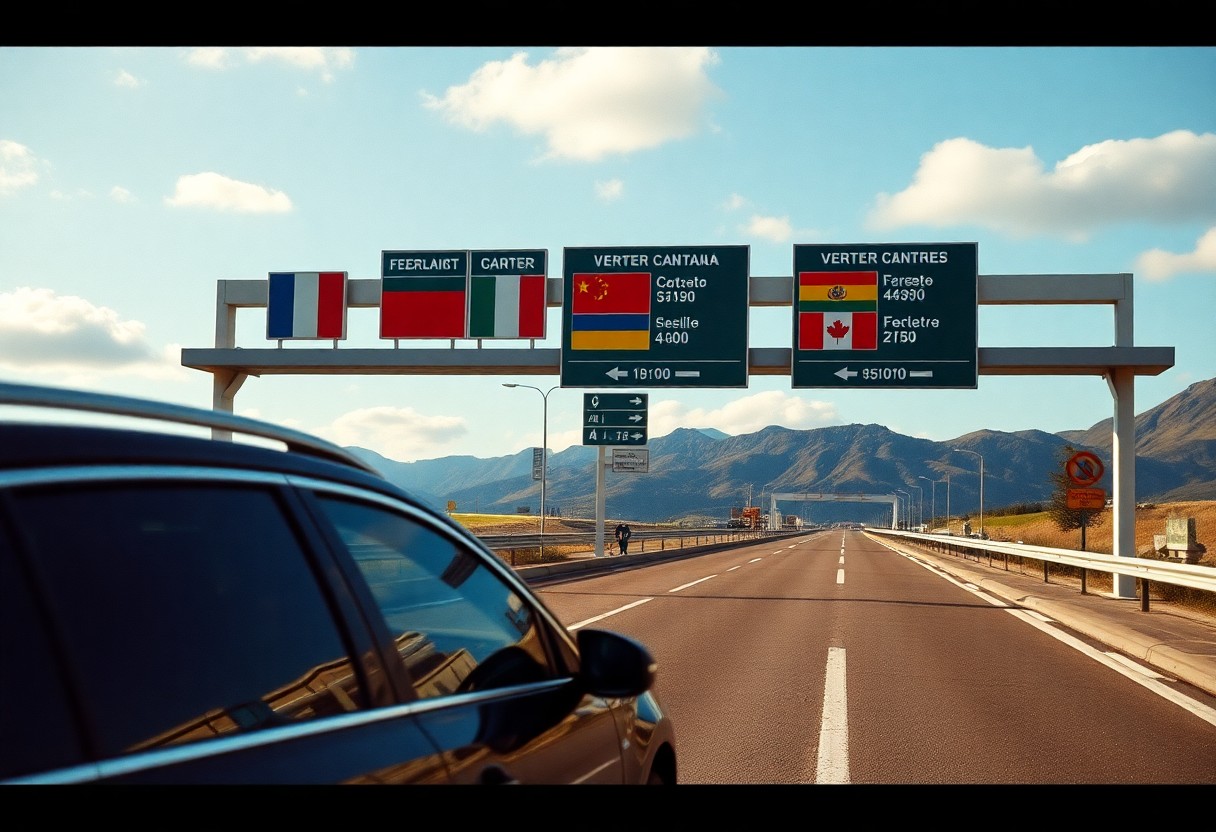Planning your overseas travel in Europe with a rental car is vital for ensuring a seamless and enjoyable journey across diverse landscapes and cultures. This preparation includes meticulous route planning and a comprehensive understanding of cross-border regulations. Each rental company enforces its own set of policies regarding travel between European nations, which can significantly impact your experience. While most rental agencies permit travel within the Western European region, many impose strict restrictions when it comes to Eastern European countries. Therefore, it’s imperative to scrutinize your rental agreement closely to identify the specific borders you can cross and any associated fees. Before you finalize your booking, confirm that your rental company allows travel to all your desired destinations, as violating these cross-border stipulations can nullify your insurance coverage and lead to hefty fines. Gaining clear insights into these restrictions is essential for a successful European road trip.
Know the Legal Essentials for Cross-Border Driving in Europe
Before starting your exciting journey across Europe in a rental car, you must adhere to specific legal criteria and requirements set by rental companies. It is crucial that your rental agreement explicitly states that cross-border travel is allowed and that you have valid insurance coverage for every country you intend to visit. Many rental agencies impose restrictions based on defined European zones, and these rules can be particularly strict for luxury vehicles. To avoid any inconveniences or disruptions during your travels, familiarize yourself with these essential requirements and ensure that you meet all legal obligations before hitting the road.
Secure Your International Driving Permit (IDP) for European Travel
One of the most important documents you will need when driving in Europe is your International Driving Permit (IDP). This permit is a prerequisite and should be procured in your home country well in advance of your travel plans. The IDP serves as a supplement to your standard driver’s license and is legally necessary in various European nations. By obtaining your IDP beforehand, you will ensure compliance with local driving laws, making your journey across multiple countries smoother and hassle-free.
Be Aware of Mileage Policies and General Travel Restrictions
When renting a car in Europe, many rental outlets offer vehicles with unlimited mileage options, which can be a great advantage for travelers planning extensive road trips. However, it’s crucial to understand that border crossing fees may apply, which can vary significantly and typically range from €5 to €47.60 per crossing, depending on the rental company and the specific countries involved. Additionally, due to insurance and security protocols, rental companies often impose specific restrictions on various categories of vehicles. Luxury brands like BMW, Mercedes, and Audi often face more stringent travel limitations compared to standard models, emphasizing the importance of declaring your travel intentions in advance to avoid unexpected costs.

Discover Cross-Border Policies of Leading Rental Companies
When renting a car in Europe, understanding each rental company's unique cross-border policies is vital for a stress-free experience. Major rental companies generally permit travel between Western European nations, but you will encounter strict restrictions for Eastern European destinations. These policies can vary greatly depending on the type of vehicle rented, with luxury cars often subjected to more limitations than standard vehicles. By comprehensively understanding these policies beforehand, you can make well-informed decisions regarding your rental options and travel itinerary.
Explore Cross-Border Regulations from Avis and Enterprise
Avis and Enterprise are two well-known rental companies that offer extensive coverage throughout Western Europe. Their vehicles are typically approved for travel in most EU countries, including popular tourist spots like France, Germany, and Spain. However, it is essential to recognize that both agencies impose specific restrictions on luxury vehicles, especially regarding travel into Italy. For example, Enterprise applies a daily cross-border fee of €5, which caps at a total of €50. Familiarizing yourself with these fees and restrictions will aid in budgeting effectively for your travels across Europe.
Review Cross-Border Driving Policies of AutoEurope and Hertz
Among the major rental providers, AutoEurope and Hertz enforce specific country restrictions that are crucial for international travelers to understand. For instance, taking their vehicles into Eastern European nations like Albania, Belarus, or Ukraine is strictly forbidden. Furthermore, Hertz prohibits luxury vehicles and SUVs from entering Italy, while AutoEurope's policies may differ based on their local partners. To ensure a hassle-free experience, it is essential to declare your travel intentions to your chosen rental provider before securing your vehicle. Your rental agreement will detail applicable cross-border fees, which can vary by company and destination. For example, Hertz charges €47.60 for crossing from Germany to another permitted country, and you may also need additional insurance coverage for international travel.
Understand Geographical Restrictions on Cross-Border Travel
The regulations governing cross-border travel with rental cars in Europe differ significantly based on the rental company and the specific vehicle type you select. Your rental agreement will explicitly list the countries you are allowed to visit with your rental car. Keeping your rental company updated on your planned route is essential, as crossing borders without proper authorization can void your insurance and lead to severe penalties, which can significantly affect your travel experience.
Identify Countries You’re Permitted to Drive In
Most rental agencies allow driving without restrictions within Western European countries, including popular destinations like France, Germany, and Spain. Zone 1 countries typically comprise EU member states in Western Europe, offering the most flexibility for your rental car. Your rental agreement will specify all the permitted countries relevant to your vehicle class, ensuring you clearly understand your travel options and limitations.
Recognize Restricted Territories for Rental Car Travel
Countries that were behind the Iron Curtain often face stringent restrictions. Most rental companies forbid travel to Eastern European nations, such as Albania, Belarus, Ukraine, and Russia, due to heightened risks and complications concerning insurance. Furthermore, additional limitations may be imposed on luxury vehicles and specific brands. High-end vehicles like BMW, Mercedes, and other premium options frequently have stricter geographical restrictions. If your travel plans involve multiple countries, it is advisable to choose a standard vehicle class to maximize your flexibility and minimize potential fees or insurance complications.
Explore Vehicle-Specific Limitations for Rental Cars
While rental companies may have diverse policies, most enforce strict regulations regarding which vehicles can cross borders. Therefore, it is essential to verify the specific limitations associated with your chosen vehicle class before making a booking. These restrictions exist to safeguard valuable assets and ensure compliance with insurance requirements across various European jurisdictions.
Enjoy Greater Flexibility with Standard Rental Cars
Contrary to popular belief, standard rental cars offer the greatest flexibility for cross-border travel. Generally, you can drive standard vehicles in most Western European countries without needing special permits. However, you must inform your rental company about your travel intentions and may need to pay cross-border fees that typically range from €5 to €50, depending on the circumstances surrounding your trip.
Understand Restrictions on Luxury Vehicles for Cross-Border Travel
Significant limitations are typically associated with high-end vehicles in the context of cross-border travel. Luxury cars often face substantial restrictions on border crossings, with brands such as BMW, Mercedes, and Audi generally prohibited from entering Eastern European countries or Italy. Typically, these luxury vehicles are confined to Zone 1 countries within Western Europe.
Moreover, if you intend to rent luxury vehicles, be prepared for higher security deposits and stricter insurance requirements. Rental companies like Sixt and Enterprise impose limitations on premium brands like Jaguar, Maserati, and Porsche, permitting them only in select Western European nations. For border crossings, special permission and potentially additional insurance coverage will be required.
Budget Wisely for Border Crossing Costs
When planning any cross-border trips in Europe with a rental car, it’s critical to keep your budget in mind. Most rental companies impose additional fees for crossing borders, even within the Schengen Area. Therefore, it is essential to communicate your intended route to the rental company and secure written permission before crossing any borders to avoid unwelcome surprises in your budget.
Explore Typical Fees Associated with Border Crossings
Border crossing fees in Europe generally range from €5 to €50, varying based on the rental company and specific conditions. For instance, you’ll incur €47.60 with Hertz when crossing from Germany to another authorized country, while Enterprise charges €5 per day, with a cap of €50 for trips starting in Germany. Being informed about these fees will contribute to effective financial planning during your travels.
Consider Potential Additional Charges and Requirements
At some borders, you may encounter extra insurance requirements and documentation fees. Your rental agency might charge for special permits, especially when traveling to Eastern European countries or when utilizing luxury vehicles. Additionally, consider the likelihood of higher insurance premiums for specific destinations, particularly in Italy or Eastern Europe. Be aware that some credit card insurance policies may not cover all European countries, making it necessary to purchase additional insurance from your rental company for complete peace of mind.

Mastering Ferry Travel with Your Rental Car
Not all rental companies maintain the same policies regarding ferry travel in Europe. While most agencies allow ferry travel, it’s imperative to verify the specific regulations tied to your rental. Crossing water borders often necessitates additional documentation and may incur extra fees that you should be prepared for. Moreover, your insurance coverage could change when traveling by ferry, making it essential to comprehend these factors before you embark.
Gain Insight into Company-Specific Ferry Policies
Among major rental companies, ferry travel policies can vary significantly. Avis and Hertz generally allow ferry travel to approved nations, but it’s essential to verify destination restrictions beforehand to prevent complications. Conversely, Enterprise and Sixt may mandate pre-authorization and additional insurance for ferry crossings, which must be clearly outlined in your rental agreement to avoid any misunderstandings.
Consider Important Aspects of Breakdown Coverage
Another crucial aspect to consider is vehicle breakdown coverage when ferry travel is involved. Most rental companies hold you responsible for vehicle repatriation costs if your car breaks down after a ferry crossing, which can escalate to thousands of euros, depending on your location and the type of vehicle rented. This responsibility extends beyond mechanical failures; if you experience an accident or if the vehicle becomes unusable for any reason while on an island, you are liable for the costs needed to return the vehicle to the original rental location. Some rental companies do offer additional insurance to cover these expenses, but it is crucial to purchase it prior to your journey to ensure proper protection.
Key Takeaways for Cross-Border Driving with Rental Cars
When planning to drive a rental car across European borders, comprehensive research and an understanding of the specific rules set by your rental company are crucial. While you may have the freedom to traverse borders in numerous European countries, keep in mind that each rental agency has its own policies and fees that you must consider. The type of rental vehicle you choose can significantly influence your travel options, with luxury vehicles often facing stricter regulations than standard models. Always confirm the countries you are permitted to visit, account for any necessary border crossing fees, and review the ferry travel guidelines before embarking on your journey. A close examination of your rental agreement and obtaining an International Driving Permit will further equip you for a successful trip. Thoughtful advance planning is the key to navigating any complications at border crossings, ensuring a more enjoyable and hassle-free travel experience.
Frequently Asked Questions About Driving Rental Cars in Europe
Can I drive my rental car to any country in Europe?
No, rental companies enforce specific regulations regarding the countries you are allowed to visit. Most agencies permit travel within Western European nations like France, Germany, and Spain. However, many impose restrictions on travel to Eastern European countries such as Albania, Belarus, and Ukraine. Luxury vehicles usually face additional limitations. Always check your rental agreement to confirm the allowed countries before attempting any border crossings.
Will I incur extra fees for crossing borders with a rental car in Europe?
Yes, numerous rental companies impose border crossing fees. For example, Hertz charges €47.60 for each border crossing from Germany, while Enterprise charges €5 per day (with a maximum of €50) for trips originating in Germany. These fees are applicable even when traveling within the Schengen Area. It is critical to inform the rental agency about your travel itinerary and settle these fees prior to crossing any borders.
Can I take my rental car on a ferry between European countries?
Yes, the majority of rental companies permit ferry travel if your destination country is included in their approved list. However, if your vehicle breaks down while on an island, you will be responsible for the costs associated with returning the vehicle to its original rental location. Some companies, such as Hertz, provide coverage for ferry travel through their insurance options (CDW, TP, or SuperCover). Always verify the specific ferry policies stated in your rental agreement to avoid any surprises.
The Article: Is It Allowed to Drive a Rental Car Across European Borders? appeared first on https://rentacar24.org/
The Article Driving a Rental Car Across European Borders: Is It Allowed? Was Found On https://limitsofstrategy.com



You’ve nailed it with the importance of planning when it comes to renting a car in Europe! I remember my last trip, and navigating the different regulations was a bit of a maze. We almost booked a company that didn’t allow us to cross certain borders, which would have totally thrown off our itinerary. It’s wild how one policy can change your entire travel experience.
It sounds like you really had quite the experience on your trip. Those regulations can be a real puzzle, can’t they? I’ve heard from many travelers who found themselves in similar situations. It’s so easy to get swept up in the excitement of planning the trip and overlook those critical details.
It’s great to hear you found planning so crucial for your trip! Navigating the different regulations can definitely feel like a puzzle at times. The situation you described about border crossing restrictions is something many travelers overlook. It’s easy to get caught up in the excitement of planning an itinerary and forget about those little details that can really shape your journey.
You’ve made some excellent points about the intricacies of renting a car for cross-border travel in Europe. I remember planning a road trip along the Adriatic Coast and how daunting it was to navigate the different policies of each rental agency. It was a real eye-opener to see how the nuances in regulations can shape our travel experiences.
I completely relate to the experience of planning a road trip along the Adriatic Coast. It really is a beautiful region, but the different rental policies can make the excitement of travel feel a bit overwhelming. Each country has its own set of rules, and one unexpected fee can add stress to what should be a fun adventure.
It sounds like you had quite the adventure along the Adriatic Coast! Planning a road trip there is definitely a mix of excitement and a bit of stress, especially with all the different policies that can come into play. Each rental agency really does seem to have its own set of rules, which can feel like a puzzle at times.
Planning a road trip along the Adriatic Coast did feel like piecing together a puzzle, especially with so many varying policies from rental agencies. I learned firsthand how crucial it is to read the fine print and clarify anything that seems ambiguous.
Planning a road trip along the Adriatic Coast was definitely a blend of thrills and a few head-scratchers. Each rental agency’s rules can feel like a mini scavenger hunt—finding the right fit for your needs and budget can be tricky. I ended up comparing quite a few policies, and I learned that being proactive pays off.
Navigating the maze of rental policies in Europe can feel like a puzzle at times, and your experience along the Adriatic Coast sounds like it captured that complexity perfectly. Each country has its own set of rules, and even different rental companies within the same country can vary widely in their approaches to cross-border travel. It’s like a hidden layer of adventure that adds a unique flavor to the journey, even if it initially comes with a bit of stress.